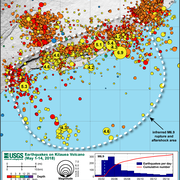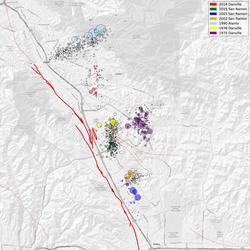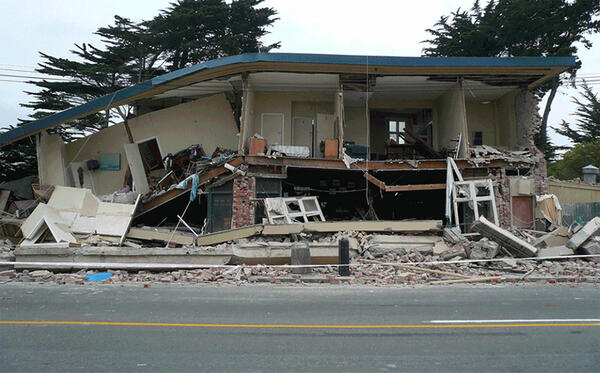Building damanged by the February 2011 earthquake in Christchurch, New Zealand.
What is the probability that an earthquake is a foreshock to a larger earthquake?
Around the world, the likelihood that an earthquake will be followed by a larger earthquake nearby and within a week is about 5%.
When an earthquake occurs, it can trigger other earthquakes nearby in what seismologists call an earthquake sequence. In most sequences, these later earthquakes will be smaller than the first one. The first, largest earthquake is called the mainshock and the later, smaller earthquakes are called aftershocks.
Occasionally, a new earthquake will be larger than any of the earlier events. When that happens, we call the new, largest earthquake the mainshock and we call all the earlier earthquakes in the sequence foreshocks. Observations show that the chance of an earthquake being followed by a larger one nearby and within a week is about 5%.
That 5% foreshock probability varies with the activity level of an aftershock sequence. Some earthquakes will have more or fewer aftershocks than average making them more or less likely to be followed by a larger earthquake, respectively. The USGS releases aftershock forecasts for all mainshocks with magnitude greater than 5 in the U.S. and its territories. These forecasts provide more accurate estimates of aftershock and foreshock probabilities.
Learn more:
Related
What is seismic hazard? What is a seismic hazard map? How are they made? How are they used? Why are there different maps, and which one should I use?
What are the earthquake hazards/risks where I live?
How will my house hold up in an earthquake? Can the USGS send someone out to evaluate my property?
How do earthquakes affect buildings?
What is the difference between earthquake early warning, earthquake forecasts, earthquake probabilities, and earthquake prediction?
How are engineers working to make roads and buildings safer?
What is the USGS doing to mitigate and respond to earthquake hazards?
Foreshocks, aftershocks - what's the difference?
What is the difference between aftershocks and swarms?
Building damanged by the February 2011 earthquake in Christchurch, New Zealand.
Earthquake information products and tools from the Advanced National Seismic System (ANSS)
United States Geological Survey (USGS) Natural Hazards Response
Putting down roots in earthquake country: Your handbook for earthquakes in the Central United States
Earthquake hazards: A national threat
Putting down roots in earthquake country: Your handbook for the San Francisco Bay region
The USGS Earthquake Hazards Program - investing in a safer future
USGS National Seismic Hazard Maps
Foreshocks and aftershocks of the great 1857 California earthquake
Occurrence patterns of foreshocks to large earthquakes in the western United States
Related
What is seismic hazard? What is a seismic hazard map? How are they made? How are they used? Why are there different maps, and which one should I use?
What are the earthquake hazards/risks where I live?
How will my house hold up in an earthquake? Can the USGS send someone out to evaluate my property?
How do earthquakes affect buildings?
What is the difference between earthquake early warning, earthquake forecasts, earthquake probabilities, and earthquake prediction?
How are engineers working to make roads and buildings safer?
What is the USGS doing to mitigate and respond to earthquake hazards?
Foreshocks, aftershocks - what's the difference?
What is the difference between aftershocks and swarms?
Building damanged by the February 2011 earthquake in Christchurch, New Zealand.
Building damanged by the February 2011 earthquake in Christchurch, New Zealand.











